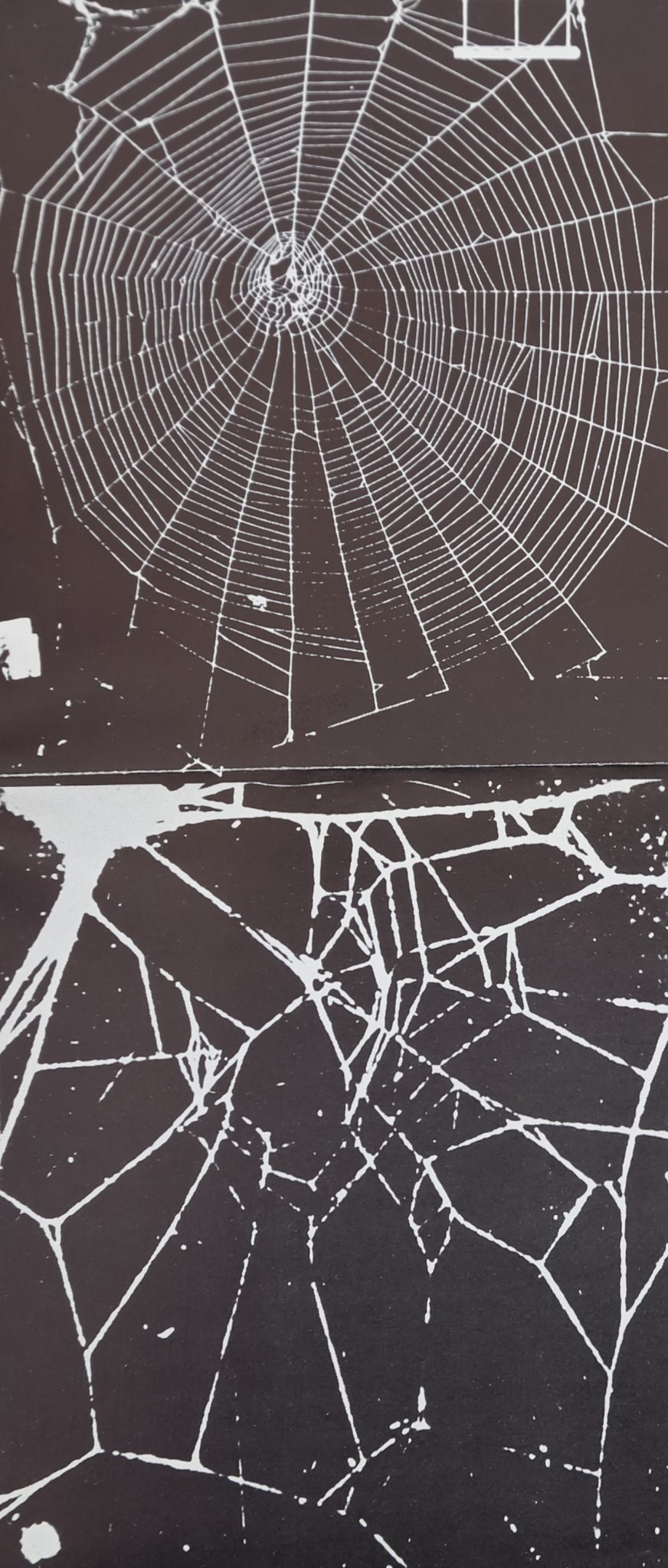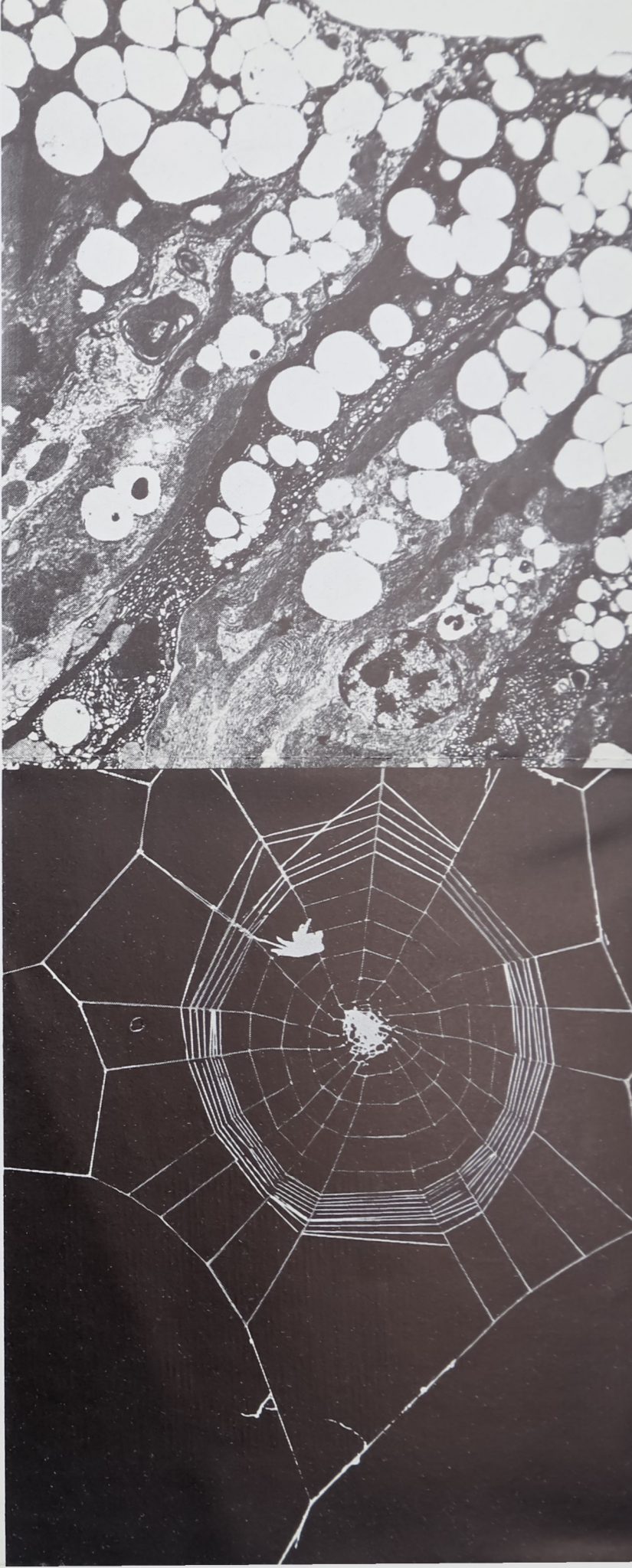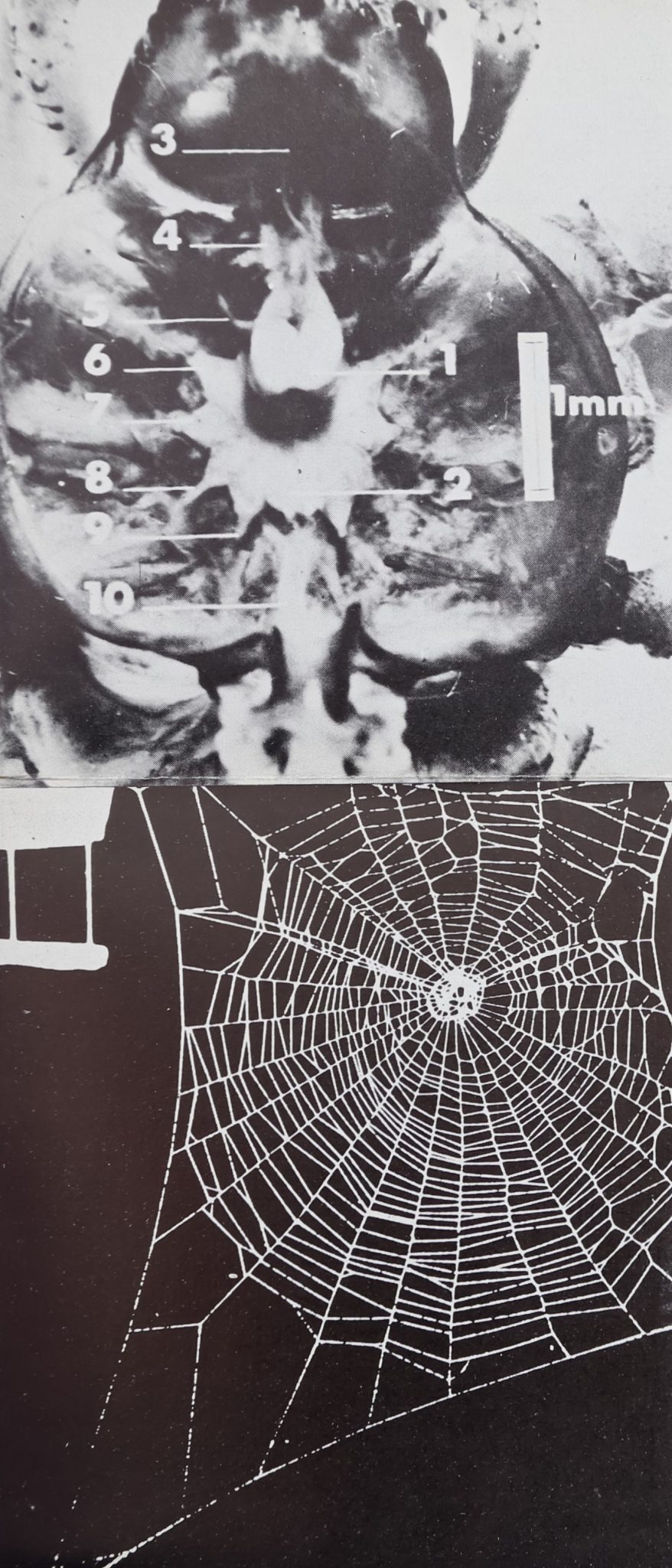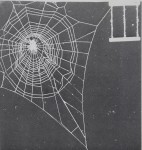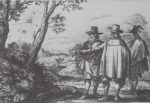Warning: Trying to access array offset on value of type null in /home/elisew5/public_html/drpeterwitt.com/wp-content/plugins/contextual-related-posts/includes/content.php on line 49
Images Collection
View this article in Search Friendly Plain Text
NOTE: This plain text article interpretation has been digitally created by OCR software to estimate the article text, to help both users and search engines find relevant article content. To read the actual article text, view or download the PDF above.
SPIDERS
WEB
. an object of beauty… an engineering accomplishment… a performance record* which can be measured … a complex i structure consisting bf Several polypeptides which the animal synthesizes in its silk glarrds… 1
PROBLEMS IN REGULATORY BIOLOGY
SPRINGER-VERLAG NEW YORK INC.
WITT/REED/PEAKALL
Figure 4. The “normal” web of an adult female Araneus diadematus Cl. spider as it is built nearly daily in the early morning hours in the laboratory.
Observe asymmetry and irregularities in the geometric pattern.
A SPIDER’S WEB
PROBLEMS IN REGULATORY BIOLOGY
By PETER N. WITT, M.D., Director of Research, North Carolina
Department of Mental Health, Raleigh, N.C.;
CHARLES F. REED, Professor of Psychology,
Temple University, Philadelphia, Pa., Ph.D. in Psychology, and DAVID B. PEAKALL, Assistant Professor of Pharmacology, State University of New York, Upstate Medical Center, Syracuse, N.Y., Ph.D. in Science, established investigator of the American Heart Association.
with 47 figures, viii, 107 pages. Cloth. $9.00 Scheduled for publication December 1968.
About 20 years ago it had been discovered that spiders, after receiving drugs, built strangely distorted orb-web patterns. This phenomenon was widely discussed in the popular press during the following years; it also stimulated much research into the sensory motor behavior of spiders during web construction.
A SPIDER’S WEB. Problems in Regulatory Biology, in a multidisciplinary approach, brings all this information together.
Figure 5, After ingestion of a high dose of caffeine with a drop of sugar water the day before, a spider built this severely distorted web pattern.

Figure 1. Electron micrograph of epithelium of ampullate glandiwhich produces scaffolding silk. Observe bubbles of silk-polypeptide which empty into gland lumen at upper right.
Production of silk material at the cellular level is explored with biochemical and histological methods, and a regulatory cycle of polypeptide synthesis is discovered. Drugs can interfere with such regulation, and more or less silk becomes available for construction of the web; the amount of detail in the geometric pattern is intimately related to thread material through thread thickness and length. Neural feedback systems from the glands and body surface help in achieving a common end point for material supply and its even distribution in the trap. Adaptive mechanisms aid in reaching the goal—an efficient net to catch flying prey —even if disturbances appear during construction. Methods for raising and keeping spiders in the laboratory, measuring and analyzing the web, and observing the animals in activity are described. A number of strange drug webs and individual variation in patterns can be expressed in size, regularity and shape measures. Statistical comparisons with control webs are performed with the aid of the digital computer. A way is proposed in which all such behavior is coded in the animal’s central nervous system.
The book is understandable and of interest to teachers, scientists and students who want to follow the ways in which biophysics and biochemistry join efforts with neurophysiology and pharmacology to help elucidate a complex behavior problem. Everybody can see the beauty and complexity of a spider’s orb-web on a sunny morning; but the enjoyment of looking at it and the curiosity about it are much enhanced through reading this book and following the ways by which laboratory research has succeeded in clarifying some of its mysteries.
Figure 3. Web under construction: hub, radii, frame and temporary spiral have been completed, and the sticky permanent spiral has been started at the periphery. Cues for construction can be tested through burning of threads or exchanging spiders from one web to another. _____£__

Figure 2. After removal of carapace, the relatively large central nervous system with its (1) supra- and (2) infraesophageal nerve masses can be discerned. The information for the web-pattern is stored here, and its integration with signals from glands and legs is essential for smooth motor execution of the geometric orb.
TABLE OF CONTENTS
Preface
1. The Story of the Drug Web (Peter N. Witt)
2. The Silk Glands (David B. Peakall)
3. Specificity of the Web (Peter N. Witt)
4. Altered Web Patterns
(Charles F. Reed and Peter N. Witt)
4. Construction of the Web (Charles F. Reed)
Other Titles of Interest
THE PHYSIOLOGICAL CLOCK Revised Second Edition By E. BÜNNING
126 figs., viii, 167 pp. 1967, Soft-cover. $3.00 (THE HEIDELBERG SCIENCE LIBRARY, VOLUME 1)
An examination of the biological measurement of time from unicellular organisms to man.
EXTINCT AND VANISHING ANIMALS By V. Ziswiler
Translated by F. and P. Bunnell
74 figs., x, 133 pp. 1967, Soft-cover. $3.40
(THE HEIDELBERG SCIENCE LIBRARY, VOLUME 2)
A review for scientist and laymen alike of the progressive destruction of nature, particularly animal life.
BIOLOGY OF ANTIBIOTICS By H. ZÄHNER and W. K. MAAS
Translation based on Zähner’s “Biologie der Antibiotica”.
Soft-cover In Preparation
(THE HEIDELBERG SCIENCE LIBRARY, VOLUME 4)
In spite of the disruption in the biological equilibrium it has become impossible for man to live without antibiotics. This volume is an important contribution to the study of the biology of antibiotics.
Figure 6.600 mg/kg d-amphetamine caused 12 hours later a characteristic kind of irregularity which can be expressed as a significant change in inter-spiral and central angle measures.

ORDER FORM
from your bookseller or: SPRINGER-VERLAG NEW YORK INC.
175 Fifth Avenue New York, N.Y. 10010
Also send from THE HEIDELBERG SCIENCE LIBRARY:
_copies of Volume 1—Biinning
Title Number 103911. $3.00
□ Please send me more information about THE HEIDELBERG SCIENCE LIBRARY
□ Bill me D Bill my institution
□ Payment enclosed (no postage charge on prepaid orders). Include New York sales tax where applicable.
0 SPRINGER-VERLAG NEW YORK INC.
Please send me
_copies of
WITT/REED/PEAKALL: A Spider’s Web.
Title Number 101528 $9.00
_copies of Volume 2—Ziswiler
Title Number 103912. $3.40 Name—
_copies of Volume 4—
Zähner/Maas Title Number 103914..
In Preparation
Institution_
Address.
City_
_State_Zip–
12/6B 29M
Printed in USA
